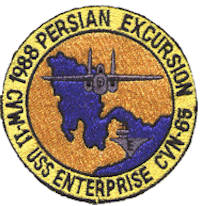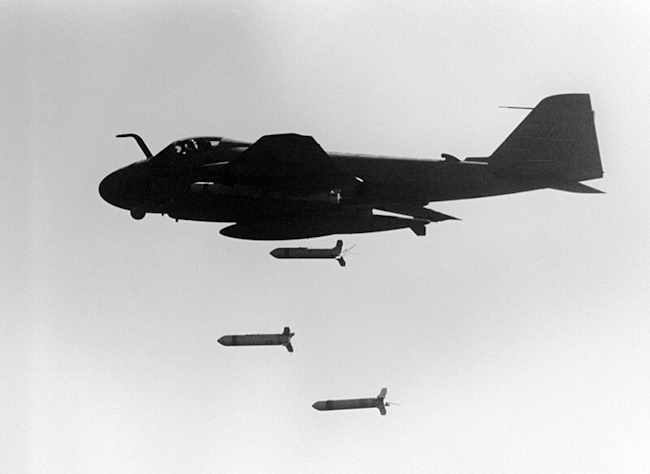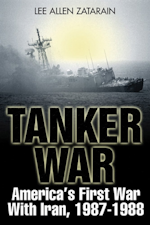Disclaimer Notice
Okay. before anything I want to say something here. I used several sources of information to write this article. I also consulted with my veteran Lizard bubbas on this and I was also there as a Green Lizard flight deck troubleshooter April 18th 1988. I remember a lot of that day, but some details after 36 years are a wee bit fuzzy. So if you see something needing correction, do let me know. Send me the corrected details and something to back that info up. Not that I dont trust your information, but we are all infallible and getting another bubba to corroborate that is a huge win for all of us. Thanks
Prelude to Operation Praying Mantis
On April 14, 1988, during Operation Earnest Will, the guided missile frigate USS Samuel B. Roberts hit a mine in the Persian Gulf. The explosion ripped a 25-foot hole in the hull, almost causing the ship to sink. Thanks to the crew’s heroic efforts, the ship was saved without any casualties and was towed to Dubai on April 16. In retaliation, the United States initiated Operation Praying Mantis on April 18, 1988.

Hormuz Highway Patrol Patch – Persian Gulf Operation Earnest Will Patch
Largest Naval Battle Since World War II
Operation Praying Mantis, in 1988, was the largest naval confrontation for American surface forces since World War II. The operation led to the sinking of two Iranian warships, one armed Boghammer speedboat and the crippling of another Iranian frigate. It also marked the first-ever surface-to-surface missile exchange in U.S. Navy history.
Order of Battle
U.S. Naval Order of Battle
Surface Action Group Bravo
On Scene Commander: Commander, Destroyer Squadron Nine (Embarked on Merrill)
USS Merrill – destroyer
USS Lynde McCormick – guided missile destroyer
USS Trenton – amphibious transport dock
Marine Air-Ground Task Force (MAGTF) 2–88 (4 AH-1T’s, 2 UH-1’s, 2 CH-46’s)
Helicopter AntiSubmarine Squadron 44 Detachment 5 – LAMPS Helicopters (SH-60B)
Surface Action Group Charlie
USS Wainwright (DLG/CG-28) – guided missile cruiser
USS Bagley (FF-1069) – frigate
USS Simpson (FFG-56) – guided missile frigate
SEAL platoon
Surface Action Group Delta
USS Jack Williams (FFG-24) – guided missile frigate
USS O’Brien (DD-975) – destroyer
USS Joseph Strauss (DDG-16) – guided missile destroyer
USS Enterprise (CVN-65) and Carrier Airwing 11
Air Wing 11 operating from the aircraft carrier USS Enterprise (CVN-65)
VA-95 Green Lizards
VA-94 Mighty Shrikes
VA-22 Fighting Redcocks
VF-114 Aardvarks
VF-213 Black Lions
Additional Vessels
USS Merrill (DD-976) – destroyer
USS Lynde McCormick (DDG-8) – guided missile destroyer
USS Trenton (LPD-14) – amphibious transport dock
Marine Air-Ground Task Force (MAGTF) 2-88
Iranian Naval Order of Battle
IS Sahand (F 74) – frigate
IS Sabalan (F 73) – frigate
IS Joshan – guided missile gunboat
At least 6 Boghammar speedboats
The Battle
On April 18, the U.S. Navy launched an attack involving multiple surface warship groups and aircraft from the aircraft carrier USS Enterprise, accompanied by the cruiser USS Truxtun. The operation commenced with synchronized strikes from two surface action groups.
One of these groups, SAG Bravo, comprised the destroyers USS Merrill (which included the LAMPS Mk I helicopter detachment HSL-35 Det 1 from Helicopter Anti-Submarine Squadron Light 35) and USS Lynde McCormick, as well as the amphibious transport dock USS Trenton with its embarked Marine air-ground task force and the LAMPS helicopter detachment (HSL-44 Det 5) from USS Samuel B. Roberts. Their mission was to neutralize the weapons and military installations on the Sassan oil platform.
At 8:00 AM, the commander of SAG Bravo, who also led Destroyer Squadron 9, instructed the USS Merrill to issue a warning to the platform’s occupants, ordering them to evacuate. The inhabitants were warned in Farsi and English.
“You have five minutes to abandon the platform; I intend to destroy it at 0800.“
After waiting for 20 minutes, SAG Bravo initiated their assault. The platform retaliated with 23 mm ZU-23 anti-aircraft guns. The engagement resulted in the disabling of several ZU-23s, prompting the platform’s occupants to request a cease-fire. SAG Bravo temporarily halted their attack.

1988 Persian Excursion Patch from Carrier Airwing 11, USS Enterprise (CVN-65)
Once a tugboat carrying additional personnel cleared the vicinity, the naval forces resumed fire, eventually disabling the remaining ZU-23 guns. AH-1 Cobra helicopters completed the suppression of enemy resistance.
Marine forces then boarded the platform, capturing a wounded survivor, various small arms, and valuable intelligence. They planted explosives and, after evacuating the platform, detonated them. SAG Bravo was subsequently directed to advance northward to target the Rakhsh oil platform.
As SAG Bravo departed the Sassan oil field, two Iranian F-4 fighter jets attempted an attack but withdrew when the USS Lynde McCormick locked its fire-control radar on them. En route to the Rahksh oil platform, the attack was called off to reduce tensions and demonstrate a willingness to de-escalate.
The operation at the Sirri oil platform unfolded similarly to the events at Sassan. SAG Charlie issued timely warnings, leading most of the occupants to evacuate via a tugboat. At approximately 8:15 AM, the USS Wainwright, USS Bagley, and USS Simpson opened fire. Unlike Sassan, Sirri was an active oil-producing platform.
One of the initial shots struck a compressed gas tank, igniting the GOSP and causing the incineration of the gun crew. Consequently, the planned insertion of the SEAL platoon was deemed unnecessary due to the extensive damage inflicted by the naval gunfire.
IS Joshan is Destroyed
Iran responded approximately 3 hours later. As the battle escalated, the IS Joshan fired a Harpoon missile at USS Wainwright and its group. USS Simpson responded with four Standard missiles, followed by USS Wainwright with two more, destroying the Joshan’s superstructure. USS Bagley fired a Harpoon that missed, but the U.S. ships closed in and destroyed Joshan with naval gunfire.
The commanding officer of Wainwright directed a final warning (of a series of warnings) stating that Joshan was to “stop your engines, abandon ship, I intend to sink you”. Joshan responded by firing a Harpoon missile at them. The missile was successfully lured away by chaff.
Simpson responded to the challenge by firing four Standard missiles, while Wainwright followed with one Standard missile. All missiles hit and destroyed the Iranian ship’s superstructure but did not immediately sink it, so Bagley fired another Harpoon. The missile did not find the target. SAG Charlie closed on Joshan, with Simpson, then Bagley and Wainwright firing guns to sink the crippled Iranian ship.
SAG Bravo also detected approaching F-4s, but those dove to the deck and departed as they reached SM-1 range). The Wainwright is SM-2 equipped. As the F-4 continued to close, ignoring warnings on both military and internal air defense circuits, the SAG Commander fired two missiles and hit the Iranian aircraft. Only the pilot’s heroic efforts enabled the Iranians to recover the badly damaged aircraft at Bandar Abbas. At this point, SAG Charlie was through for the day, as well.
Boghammar Speedboats Attack
Approximately three hours later, Iran retaliated by deploying Boghammar speedboats to attack various targets in the Persian Gulf. These targets included the American-flagged supply ship Willie Tide, the Panamanian-flagged oil rig Scan Bay, and the British tanker York Marine. The situation escalated when the they came under attack by Iranian Boghammers.
The USS Joseph Strauss provided initial coordinates to help A-6 Intruder aircraft locate and engage the high-speed boats. Two VA-95 aircraft deployed Rockeye cluster bombs on the speedboats, successfully sinking one. The aircrew that sunk the Boghammer was Lt. Jack Webb and Lt. Mark Heath. All of these vessels sustained damage from Mk-20 Rockeye II cluster bombs.

VA-95 A-6E Intruder in Operation Praying Mantis (U.S. Navy Grumman A-6E Intruder from attack squadron VA-95 Green Lizards aircraft dropping CBU-59 cluster bombs over Iranian targets in retaliation for the mining of the guided missile frigate USS Samuel B. Roberts (FFG-58) on 18 April 1988. VA-95 was assigned to Carrier Air Wing 11 (CVW-11) aboard the aircraft carrier USS Enterprise (CVN-65)

Aerial photograph of the Iranian Frigate Sahand after being attacked by VA-95 Green Lizard Intruders
The Crippling of IS Sabalan (73)
During the Iran-Iraq War, the IS Sabalan became notorious for attacking unarmed and neutral tankers and other merchant vessels. Before launching these attacks, Sabalan’s captain would often board the ships under the guise of conducting a friendly inspection, sometimes even dining with the ship’s master. After this deceptive display, he would open fire on the vessel, targeting the bridge and living quarters. Frequently, the captain would radio a mocking farewell, saying “Have a nice day” as the Sabalan departed. These actions earned him the moniker “Captain Nasty.”
Later in the day, the Iranian frigate IS Sabalan set out from its berth. Another squadron of “Green Lizard” A-6E Intruders was dispatched to Sabalan’s reported location in the strait. At 6:17 PM Gulf time, the Sabalan fired upon the A-6s. At 6:18 PM, one A-6 dropped a Mk-82 500-pound laser-guided bomb, leaving the Sabalan immobilized and ablaze.
Lieutenant Commander James Engler, the pilot, Lieutenant Commander John Schork was the BN are the Intruder aircrew who disabled the Sabalan, was awarded the Distinguished Flying Cross by Admiral William J. Crowe, Chairman of the Joint Chiefs of Staff, for his actions against the Sabalan and the Iranian gunboats.

The Iranian Frigate Sabalan (IRIS Sabalan 73)
With its stern partially submerged, the Iranian frigate was towed by an Iranian tug, eventually repaired, and returned to service. Following orders, VA-95’s aircraft did not continue the attack. In retaliation, Iran launched Silkworm missiles, likely the HY-4 variant, from land bases targeting SAG Delta in the Strait of Hormuz and the USS Gary in the northern central Persian Gulf. However, all missiles missed due to the ships’ evasive maneuvers and use of decoys.
Disengagement
Following the attack on the Sabalan, U.S. naval forces were instructed to adopt a de-escalatory stance, offering Iran an opportunity to step back and avoid further conflict. Iran accepted this opportunity, leading to a cessation of combat, though both sides stayed on high alert. Near-clashes were reported throughout the night and into the following day as the forces navigated within the Gulf.
Two days after the battle, the USS Lynde McCormick was tasked with escorting a U.S. oiler through the Strait of Hormuz, accompanied by a Scandinavian-flagged merchant ship likely seeking protection. Despite maintaining a heightened state of readiness, no further hostile actions were detected, signaling the end of the clash.
Aftermath
 By the time the sun set on April 18, all objectives of Operation Praying Mantis had been accomplished. The mission resulted in no civilian or U.S. casualties, and there was minimal collateral damage. The operation delivered a decisive and devastating blow to the Iranian war effort. Iranian naval and intelligence facilities on two oil platforms were damaged, the Joshen and Sahand were sunk, the Sabalan was left dead in the water, and at least one Boghammar speedboat was sunk.
By the time the sun set on April 18, all objectives of Operation Praying Mantis had been accomplished. The mission resulted in no civilian or U.S. casualties, and there was minimal collateral damage. The operation delivered a decisive and devastating blow to the Iranian war effort. Iranian naval and intelligence facilities on two oil platforms were damaged, the Joshen and Sahand were sunk, the Sabalan was left dead in the water, and at least one Boghammar speedboat was sunk.
The oil platforms were eventually repaired, the IS Sabalan (73) was towed into port and restored by 1989 and remains in service.
The U.S. side suffered two casualties: the crew of a Marine Corps AH-1T Sea Cobra attack helicopter. The Cobra, attached to the USS Trenton, was conducting reconnaissance from the USS Wainwright and crashed after dark about 15 miles (24 km) southwest of Abu Musa Island.
VA-95’s Impact on Operation Praying Mantis
We left on this cruise knowing our purpose originally was to support the Earnest Will Missions. We left as a “Heavy” squadron. We took along extra Intruders beyond our normal complement of 10 bombers and 5 tankers. I think we took 5 extra bombers, Skipper Miller who was our Commanding Officer at the time says we had 18 total. I am not sure at this point, but sooner or later someone will pipe up and we’ll all be squared away.
Most of our bombers were loaded with a WASEx package. This was our typical “war at sea” ordnance loadout. x1 mk82 LGB (500lb bomb), a Harpoon anti-shipping missile, 5 or 6 Rockeye cluster bombs (depending on which station), and 2 drop tanks. There would of been WASEx options of one drop tank and a single AGM-123 Skipper which is a 1000lb bomb fitted with a rocket motor and laser guidance package.
Dan Stumpp was the Plane Captain Of “Lizard 500” Bureau # 156995. This was the Intruder that started the 95th All Weather Attacks “shooting war” with Iran. It was piloted by Commander Bud Langston and his Bombardier Navigator (BN) was Lt Bob “Pappy” Papadakis. His aircraft’s loadout was 1 Harpoon Missile, 1 AGM-123 Skipper, and pair of Mk82 Laser Guided Bombs (LGB’s) (GBU-12 Paveway).

VA-95 “Lizard 503” with a WASEx loadout, April 18 1988
From a personal standpoint, simply put, we kicked some butt that day. Check it out:
- Lizard Intruders were the primary players in sinking the Sahand.
- Lizard Intruders killed a boghammer speedbopat with a clusterbomb.
- A Lizard Intruder crippled the sabaln, leaving her dead in the water
- Some of our KA-6D tanker crews flew 7 hour missions keeping the airwing fueled shuttling fuel from KC-10 tankers to our airwing.
- We achieved a 100% sortie rate.
- Lizard Aircrews logged 108 hours of flight time
- Between the 18th and the last Intruder recovery on the 19th, aircrews logged 187 hours flight time.

VA-95 Grumman A-6 “Lizard 506” with 500lb LGB and Harpoon missile loadout
Our performance in the air couldn’t have happened without the incredible work on the flight deck and in the aircraft hangers aboard the ship by the Green Lizard maintenance team. All of us sailors were motivated, and dedicated and gave 100% plus to keeping our jets in tip-top shape, READY for our awesome aircrews. When you become the instrument of your nation’s will and determination…, you give everything to it. All Lizards from Airframes, to the AZ’s in Maintenance Control, to our cooks in the galley performed as an awesome team.
Awards
All ships received the Joint Meritorious Unit Award and the Combat Action Ribbon. Sailors assigned or attached to the ships (and temporarily assigned sailors deemed necessary by the ship’s commanding officer) who were present and participated in Operation PRAYING MANTIS are authorized to wear these awards permanently.
Lieutenant Commander James Engler and Lieutenant Commander Nortz, were awarded the Distinguished Flying Cross
Historical Significance

Operation Praying Mantis is considered decisive in establishing U.S. naval superiority, as highlighted by Naval Academy Professor Craig L. Symonds in his book “Decision at Sea” (2005). It stands alongside other significant naval battles like the Battle of Lake Erie, Battle of Hampton Roads, Battle of Manila Bay, and Battle of Midway.
1980’s U.S. Navy in the Persian Gulf Books
Operation Praying Mantis Videos
USS Enterprise OPMAN ’88, APRIL18,1988
Navy Remembers Operation Praying Mantis
Operation Praying Mantis
America Obliterates Half Of Iran’s Navy In 8 Hours! – Operation Praying Mantis
References/Sources Consulted
Operation Praying Mantis – Wikipedia
One Day of War
OPERATION PRAYING MANTIS: AN ENTERPRISE COMBAT MISSION
CVN-65 1988 COMMAND HISTORY
The Air View: Operation Praying Mantis
The Surface View: Operation Praying Mantis By Captain J. B. Perkins III, U. S. Navy
BETTER LUCKY THAN GOOD: OPERATION EARNEST WILL AS GUNBOAT DIPLOMACY
Operation Praying Mantis
Operation Praying Mantis
Operation Praying Mantis
Ships in The Persian Gulf 1987-1988
United States Navy Ships
Iranian Navy Ships
IRIS Sabalan (73)
IRIS Sahand (1969)
La Combattante II type fast attack craft
List of ships sunk by missiles






